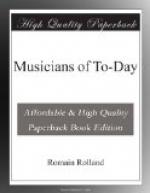* * * * *
4. The Chamber-Music Societies
On parallel lines with the big symphony concerts and the new conservatoires, societies were formed to spread the knowledge of, and form a taste for, chamber-music. This music, so common in Germany, was almost unknown in Paris before 1870. There was nothing but the Maurin Quartette, which gave five or six concerts every winter in the Salle Pleyel, and played Beethoven’s last quartettes there. But these performances only attracted a small number of artists;[236] and so far as the general public was concerned the Societe des derniers quartuors de Beethoven had the reputation for devoting itself to a singular and incomprehensible kind of music that had been written by a deaf man.
[Footnote 236: The quality of the audience atoned, it is true, for its small numbers. Berlioz used to come to these concerts with his friends, Damcke and Stephen Heller; and it was after one of these performances, when he had been very stirred by an adagio in the E flat quartette, that he burst out with, “What a man! He could do everything, and the others nothing!”]
The true founder of chamber-music concerts in Paris was M. Emile Lemoine, who started the society called La Trompette. He has given us a history of his work in the Revue Musicale (15 October, 1903). He was an engineer at the Ecole Poly-technique; and after he had left school he formed, about 1860, a quartette society of earnest amateurs, though they were not very skilled performers. This little society continued to meet regularly, and after perfecting itself little by little, finally opened its doors to the general public, which attended the concerts in gradually increasing numbers. Then La Trompette came into being. It prospered from the day that M. Saint-Saens—who was at that time a young man—made its acquaintance. He was pleased with these gatherings, and became an intimate friend of Lemoine; and he interested himself in the society, and induced other celebrated artists to take an interest in it, too. Among its early friends were MM. Alphonse Duvernoy, Diemer, Pugno, Delsart, Breitner, Delaborde, Ch. de Beriot, Fissot, Marsick, Loeb, Remy, and Holmann. With such patronage, La Trompette soon acquired fame in the musical world, and “it represented in classical chamber-music the semi-official part played by the Societe des Concerts du Conservatoire in classical orchestral music. Rubinstein, Paderewski, Eugene d’Albert, Hans von Buelow, Arthur de Greef, Mme. Essipoff, and Mme. Menter, never missed getting a hearing there when their tours led them to Paris; and to figure on the programme of La Trompette was like the consecration of an artist.” Such a society naturally contributed a great deal to the spread of classical chamber-music in Paris. M. Lemoine writes:




